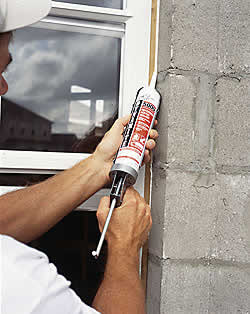
...continued from previous page
Exterior Caulking
How do you choose from the bewildering array of caulk types out there? Start by understanding their characteristics.
by John Strieder
Just as the makeup of exterior caulks varies, so do their cure times. In general, latex products can be painted one to four hours after application, but take about a day to cure. Silicones and modified silicones take between overnight and a couple of days, while polyurethanes need three to 10 days for a full cure.
Several experts recommend a caulk rod backing in any gap where a joint is at least a half inch. “Anywhere you have joints larger than a half inch you will have problems in the long term,” Hess says. “Some sealant companies claim their products will cover joints up to two inches. I think if I had a two-inch gap anywhere on my house or building I would have some major issues with my contractor.”
When should caulking be replaced? When it begins to visibly separate from a substrate, says Angela Greenwell, marketing sundry manager at PPG Industries Inc. “Good quality caulk will outlast most paint jobs,” she says.
Urethanes may oxidize on the surface and start to look ugly while still doing their job as sealants. Should they be replaced just because they look bad? Maybe, maybe not. “Nobody is really sure how long some of these things will last,” Sicree says. “I guess it depends on your definition of ‘last.’”
Ultraviolet rays will eventually cause all unpainted caulk to discolor, fade or yellow, Hess says. Silicones have a tendency to pick up dirt, he says, while polyurethanes go through a process called reversion — they revert to their original state, softening and attracting dirt like a magnet.
Cheap latex caulks with vinyl resin are more prone to yellowing from UV exposure than acrylic latex caulks, and white and light-colored polyurethanes are particularly prone to yellowing, Kermode says.
Caulk can also blacken from mildew, he says. High-end caulks resist mildew but don’t kill it, and it will bleed through even the best caulks unless it is completely removed from the substrate beforehand.
Not all caulk color is inadvertent. Exterior caulk can be custom-colored by the manufacturer. However, most of the time caulk is simply painted at the job site. “You’re better off just caulking and painting over it,” says contractor Todd Olson.
Matching paint and caulk colors is tough, Sicree says. “I don’t know if you ever get a perfect match of caulk to paint,” he says. “It’s not widely done. You just have to get close enough. But for caulk, that’s often good enough, especially on the exterior of the building.”
Caulk manufacturers mostly sell white, Burkitt notes. “Color matching comes up every year when we talk about innovation, but we haven’t seen a whole lot of it.”
Other foul-ups are more serious than an off color match. If latex caulk is exposed to rain before it cures, it may wash away from the joint, Kermode says, while if it is tooled or feathered out too thin, it will discolor and be more likely to pick up dirt.
Sometimes contractors paint too soon, especially considering how much caulking shrinks in the first couple of days, Sicree says. “I’ve seen people with a caulk gun in one hand and a paint brush in the other — that’s too soon.”
Also, nonlatex paints and caulks that are similar in composition may react to each other, leaving a paint surface that can stay tacky much longer than expected and even discolor, Sicree says.
On the brighter side, Sicree offers a solution to the common bugaboo of paint cracking as a seal settles underneath it. Leave the bead untooled and rounded, and it will flatten as it shrinks, putting less stress on the coat of paint, he says.
Environmental Protection Agency regulations have not altered the composition of acrylic caulks. Not surprisingly, they have had more impact on solvent-based sealants.
Latex caulk is relatively gentle on the environment, Hess says. “On the other hand, urethane caulks, and to some extent, silicone rubber caulks have had to evolve to be less toxic. Some of the companies that manufacture solvent-based caulks have had to alter their formulas to meet new, more stringent EPA regulations.”
The rules put the most pressure on rubber-based sealants, which have high solvent contents, Sicree says. To conform, companies are switching to the use of alternative solvents that are not listed under the new rules, he says.
Manufacturers are also developing new chemistries to replace solvent-based caulks with latex products, Burkitt says. “Volatile organic compound regulations are a huge driver in the market today.”

|

